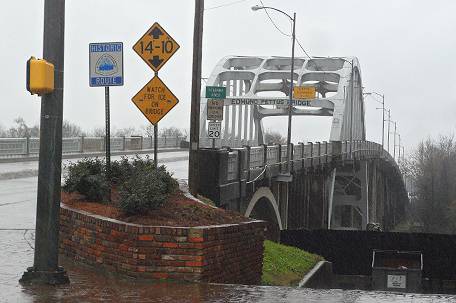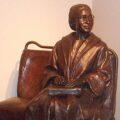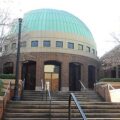
“The arc of the moral universe is long, but it bends towards justice.” –Rev. Dr. M. L. King, Jr.
Spanish explorers were the first Europeans to enter the region that is now Alabama in the early 16th century and the French followed eighty years later. They established Fort Louis de la Mobile in 1702 and a second fort, Toulouse, in 1717. Four years later the first slave ship, the Africane, entered the area with a cargo exceeding 100 slaves.
Selma’s first documented appearance on a map is as Ecor Bienville, a French village, in 1732 but local legend states that it was constructed on the footprint of Piachee, an Indian village where DeSoto met with Chief Tuskaloosa. The site was selected because it is atop a cliff overlooking the Alabama River. In the early 1800s it was known as Moore’s Bluff in reference to one of its early settlers. William Rufus King renamed the city Selma, meaning, “throne,” in 1820 when it was incorporated and was designated the Dallas County Seat in 1865.
Selma, in the heart of Dallas County and the Black Belt, had rich soil, navigable river access and enslaved labor all of which made it the area with the third greatest per capita income in the nation in 1860. In that year, the county also had the highest number of slaves, 25,760, in Alabama and the fourth highest total in the country. There were 80 free blacks and 7,785 whites.
During the Civil War Selma became an important Confederate supply depot. The city produced arms, cannons and the ironclad C.S.S. Tennessee. Confederate General Nathan Bedford Forrest fought the Battle of Selma on April 1, 1865 to keep the city from falling into Union hands and on April 2nd General James Wilson captured the city.
The St. James Hotel, located on historic Water Street, dates from 1837 and was originally called The Brantley. During the Civil War, while the owner, Dr. Gee, served in the war, he delegated the daily operation of the hotel to his slave Benjamin Sterling Turner. Turner, who had been clandestinely taught to read by Gee, would become a wealthy businessman, the state’s first African American elected to the US Congress and became one of the wealthiest men in the state. He died in poverty.
Turner is interred in Old Live Oak Cemetery. Local citizens placed a monument on his grave. Guided tours are given during the Selma [email protected].
Union soldiers occupied the hotel in 1865 and after the war the hotel accommodated Frank and Jesse James and a host of other important visitors. Frank’s favorite room was 301 and it is believed he continues to haunt it. Today it is one of the Historic Hotels of America and offers lodgings within walking distance of most of Selma’s sites and the historic district featuring an outstanding assemblage of pre-1861 industrial edifices. www.historicstjameshotel.com
Selma is best remembered for its pivotal position in the 1960s struggle for Civil Rights, “Bloody Sunday” and the Selma to Montgomery March. The city was chosen as a battleground for African American voter registration because of its location in the central Black Belt and because of its abysmal record of black registration. African Americans had been attempting to vote since the 1930s and in 1960, at the onset of the mass movement, Dallas County listed 23,952 white residents and 32,687 blacks. In Selma, more than 50 percent of the residents were black but less than 1 percent were registered voters.
Although the Civil Rights Act of 1964 made segregation of public facilities illegal the right to vote remained a major issue. Blacks who attempted to register faced violent or economic intimidation or were given unreasonable tests, being asked to give the number of jellybeans in a jar or the number of bubbles in a bar of soap. In 1962 members of the Student Nonviolent Coordinating Committee arrived in Selma.
In 1963, SNCC organizer Bernard Lafayette held a voter rally at Tabernacle Baptist Church, but just as blacks were determined to begin a serious registration campaign, whites were equally determined to end their efforts. To that end a mob gathered outside of the church and Sheriff Jim Clark menacingly entered. The following year an injunction was issued against any more than three black people gathering together. The fine was $200. The multi-columned neoclassical Tabernacle Baptist Church was built in 1922 and was designated on the National Register of Historic Places in 2013. . www.tabernacleselma.org
Eight black community leaders continued to meet in defiance of the injunction and they came to be known as the “Courageous Eight,” In December of 1964 they posted a letter to Dr. Martin Luther King requesting his assistance. On January 2, 1965 King met with the black residents of Selma for the first time. Other supporters would soon follow.
King was jailed and while he was incarcerated, Malcolm X made his first trip below the Mason-Dixon Line to Selma in support of King on Feb. 4. He and Coretta S. King addressed the masses in Brown Chapel AME Church. Malcolm also spoke in Tuskegee while on this trip.
The monument to Dr. King placed on the exterior of Brown Chapel in 1979 makes it easily recognizable. It was founded in 1866 as the state’s first AME church. It functioned as King and Abernathy’s headquarters, hosted the Southern Christian Leadership Conference (SCLC) in 1965 and served as the point of departure for the Selma to Montgomery March. The Romanesque church was built in 1906 and designed by A. J. Farley, an African American. The red brick building boasts barrel vaults, square towers and spool baluster railings. The M. L. K. Room on the interior displays artifacts and memorabilia from the Civil Rights Era.
Nearby First Baptist Church also functioned as a command post for SNCC members. It was designed by a Dave B. West, a black architect, in Victorian-style and erected in 1894. First Baptist was the first church in the city to hold meetings of the Dallas County Voters League and served as the site of both mass meetings and workshops on nonviolent techniques.
Selma’s Sheriff Jim Clark was a “true believer” in the racist policies of the 1960s and it appears made it a personal mission to stop blacks from registering to vote in the Dallas County Courthouse. Dr. King and more than 350 people were turned away from the courthouse on January 18, 1965 only to return on the 19th. On January 22nd a teacher’s march was held, they too were denied access and during these initial actions some people were beaten and arrested. The 1901 Dallas County Courthouse steps, where the majority of the confrontations took place, are located on Alabama Avenue.
 PHOTO: Jail Cell
PHOTO: Jail Cell
Approximately 600 black protestors, led by John Lewis (SNCC) and Hosea Williams (SCLC), gathered at 3 PM on Sunday, March 7, 1965 at Brown Chapel to march from Selma to the state capital. After walking six blocks they were met n the Edmund Pettis Bridge by mounted Alabama State Troopers and an irate mob of whites. The marchers did not disperse and tear gas was used. The situation escalated and the crowd was attacked and beaten. Mayhem ensued and as the people fled they were pursued into the community. The Sisters of Saint Joseph at Good Samaritan Hospital treated the injured.
”Bloody Sunday” was a watershed event in American history. The entire event was recorded and brutal images were aired on television. American and international audiences were suddenly excruciatingly aware of the injustice and the level of violence.
It is possible to reserve a tour with Joanne Bland, a participant in the protests. Her personal vignettes and stories personalize your trip in a very unique way. www.journeysforthesoul.com
The Slavery and Civil War Museum and the National Voting Rights Museum & Institution are sister museums that together present the African American experience from the kingdoms of Africa to the election of Barack Obama as President of the United States.
Your first stop should be the Slavery and Civil War Museum. Here visitors embark on an interactive experience, “Footprints of Our Ancestors,” that involves traveling the Middle Passage and being sold on an auction block. Additional galleries are filled with African artworks and artifacts.
In 1990 the National Voting Rights Museum & Institute was established by veterans of the Voting Rights Movement on the site near the Edmund Pettus Bridge where some of the most violent confrontations took place. The institution’s primary mission is to identify, document and tell the story of the foot soldiers, the ordinary participants who risked their lives and livelihoods for the right to vote. Nine galleries feature a series of exhibits.
This museum is a must. It is filled with priceless artifacts including a vest signed over a 50-year period by everyone connected with the movement, a replica jail cell, a complete Klan outfit and casts of footprints of those who marched. One of the most interesting exhibits is a series of the government’s actual surveillance photographs allowing visitors to see what the government considered important. They are mounted near a window that looks out on the scene where many of the pictures were taken. www.nvrmi.com
Sam Walker is the ultimate guide for visits to the two institutions. He is a historian and was an 11-year old participant in the protests. He was jailed and his interpretation of his experiences enhances visitors Selma experience. Reservations are required. [email protected]
Selma was once known as the “Queen City of the Black Belt” and the Old Depot Museum is the best place to put all the pieces of the city’s past together. This marvelously eclectic museum has a most wonderful variety of collections dating from 1814 housed in an 1891 Romanesque railroad depot. The collection includes a handwritten slave bill of sale, a bow and arrow made by Geronimo while he was imprisoned, a portrait of Benjamin Turner, a sweater that belonged to M.L. King and the original Bloody Sunday ER log from Good Samaritan Hospital containing names and injuries.
The Keipp Photographic Collection is one of the museum’s cultural gems. The collection contains pictures taken of area residents and they are stunning. These photos have never been exhibited outside the museum. On the exterior there is a cotton scale complete with a bale of cotton. www.olddepotmuseum.com
Lannie’s Bar-B-Que Spot on Minter Avenue was one of the organizer’s local favorites. Ironically, it was also the eatery of choice of the police force. The restaurant is still welcoming visitors and continues to serve the best BBQ in Selma.
The Selma to Montgomery National Historic Trail begins at Brown Chapel and continues 54-miles to Montgomery, the state capital. The Selma Interpretive Center will officially open in March of 2014 and will provide information on the trail and allied sites. It is situated as you enter the city and currently presents an orientation film and an exhibit gallery. When completed there will be additional displays and interactive kiosks. www.npca.org/parks/selma-to-montgomery-natl-hist-trail
Before leaving Selma you must dine in the historic Tally Ho Restaurant. The architecture is interesting, the southern cuisine is outstanding and the service is unsurpassed. This is the top rated fine dining venue in the area. www.tallyhoselma.com
The Edmund Pettus Bridge has been designated one of “10 historic landmarks that bear witness to our nation’s enduring freedoms.” This iconic structure was erected over the Alabama River in 1940 and was named in honor of an Alabama senator. The bridge is bookended by two parks, “Songs of Selma” and “Lafayette,” that have interpretive plaques with historic information.
On March 21, 1965 a second attempt was made to march to Montgomery. Approximately 3,200 people set out with Dr. King in the lead. In the next article we will follow in the footsteps of the foot soldiers, along Highway 80, the Selma to Montgomery National Historic Trail. President Clinton inaugurated the trail in 1996. In the meantime all of the information you need to plan a trip to Selma can be found on the website. Make the journey. www.selmaalabama.com
I wish you smooth travels!
TRAVEL TIPS:
One of Pennsylvania Museum’s most anticipated events, the 33rd celebration of Chinese New Year, will be held on Saturday, January 24th from 11:00 AM to 4:00 PM. This is the Year of the Horse and the gala event will include dance performances, workshops, martial arts demonstrations, crafts, a Chinese Marketplace and the exciting finale, a performance of the Lion Dance. www.penn.museum
For more than 50 years Entertainment Guides have been helping people to save money on a host of entertainment options while assisting schools and service organizations in fundraising more than $2.5-billion. The guides are specific to 120 different cities that together offer discounts at more than 250,000 locations. The 2014 guides are valid from time of purchase until December 30, 2014 and there are three ways to access savings, using the coupon book, mobile app or downloading from the website. Entertainment Guides allow you to double your options and try out new restaurants and save at the same time. Ordering and offerings information is available on the website. www.entertainment.com
This year will mark the 150th anniversary of the Battle of Atlanta as we reach the third year of the commemoration of the sesquicentennial of the Civil War. The Atlanta Cyclorama, one of the city’s top attractions, will feature art exhibits, performances and lectures throughout the year showcasing world -renowned artists. Complete scheduling and general information can be accessed online. www.atlantacyclorama.org
















Leave a Comment